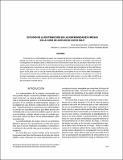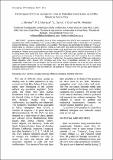Buscar
Mostrando ítems 1-10 de 30
First Report of Citrus Blight in Costa Rica
(2005-01)
Citrus blight (CB), causing a chronic decline of citrus, has been an important disease in Florida for over 100 years. CB was first reported in Brazil in the 1980s and is now responsible for the removal of nearly 10% of the ...
First Report of Xylella fastidiosa in Avocado in Costa Rica
(2008-01)
Since the late 1990s, chlorotic mottling, marginal scorch, deformation of leaves, defoliation, shortening of internodes, and branch dieback have been observed in avocado trees (Persea americana Mill.) in Costa Rica. The ...
Detection of Potyvirus-like Particles Associated with Oil Palms (Elaeis guineensis) in Ecuador
(1996-09-03)
Oil palm (Elaeis guineensis Jacq.) seedlings showing a conspicuous mottling, composed of alternating dark green and chlorotic areas in the form of discontinuous streaks or irregular ring patterns, were observed in the ...
‘Candidatus Phytoplasma costaricanum’ a novel phytoplasma associated with an emerging disease in soybean (Glycine max).
(2011-12)
A novel phytoplasma, designated strain SoyST1c1, associated with a newly emerging disease in soybean (Glycine max), known as soybean stunt (SoyST), was found in 2002 in a soybean plantation in Alajuela Province, Costa Rica. ...
Guazuma ulmifolia (Sterculiaceae), a new natural host of 16SrXV phytoplasma in Costa Rica
Guazuma ulmifolia (Sterculiaceae), un nuevo hospedero natural de fitoplasmas del grupo 16SrXV en Costa Rica
(2011-04)
Guacimo trees (Guazuma ulmifolia, Sterculiaceae) showing witches’ broom symptoms (GWB), small leaves, short internodes, stunting and no flower and fruit production were observed on side roads and fences in different areas ...
Genus Orthotospovirus in Costa Rica: A Central American case
El género Orthotospovirus en Costa Rica: Un caso centroamericano
(2023-12-28)
Objective/Background. The Orthotospovirus genus encompasses a range of economically significant and emerging plant viruses that affect a variety of crops globally. While the prevalence and characteristics of these ...
Occurrence of Squash yellow mild mottle virus and Pepper golden mosaic virus in Potential New Hosts in Costa Rica
(2013-09)
Leaf samples of Solanum lycopersicum, Capsicum annuum, Cucurbita moschata, Cucurbita pepo, Sechium edule and Erythrina spp. were collected. All samples were positive for begomoviruses using polymerase chain reaction and ...
Estudio de la distribución de las enfermedades virosas de la caña de azúcar en Costa Rica
(2006)
El estudio de las enfermedades de origen viral requiere de técnicas inmunológicas de alta precisión y confiabilidad. Haciendo uso de estas herramientas y con el apoyo del Ministerio de Ciencia y Tecnología y del Centro de ...
First report of Xylella fastidiosa infecting coffee in Costa Rica
(2001-09)
In 1995, severe symptoms were observed on ‘Caturra’ and ‘Catuaí’ coffee (Coffea arabica L.) varieties in farms in the southern part of the Central Valley in Costa Rica. Symptoms were reduced leaf size, malformation of ...
First Report of Citrus variegation virus in Palestine Sweet Lime, as Coffee Shade in Costa Rica
(2011)
Symptoms resembling those of Citrus variegation virus (CVV) were observed in old Palestine sweet lime trees (Citrus limettioides Tan.) used as coffee shade in the Central Valley in Costa Rica. The symptoms include leaf ...





